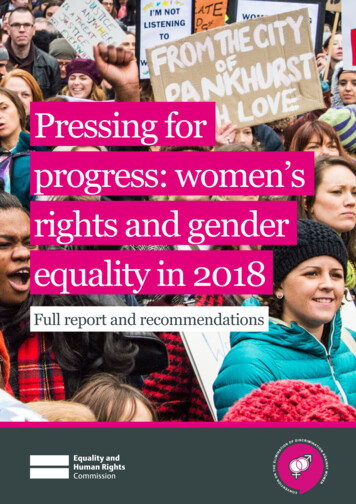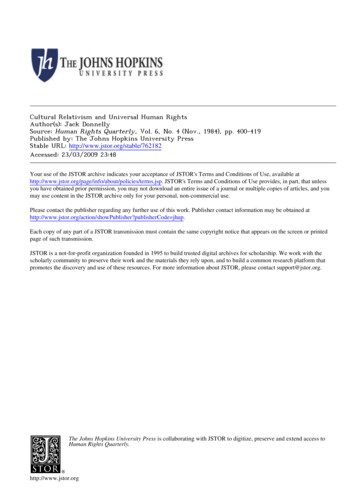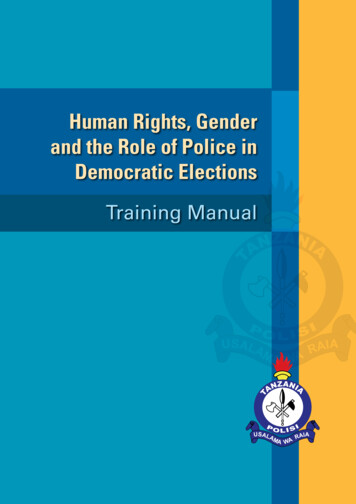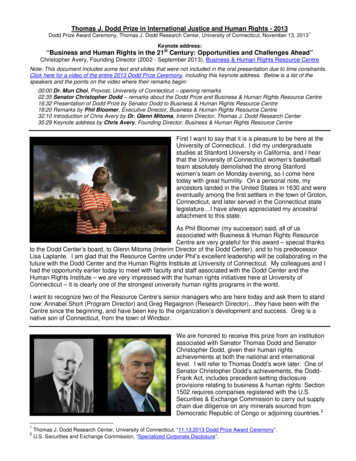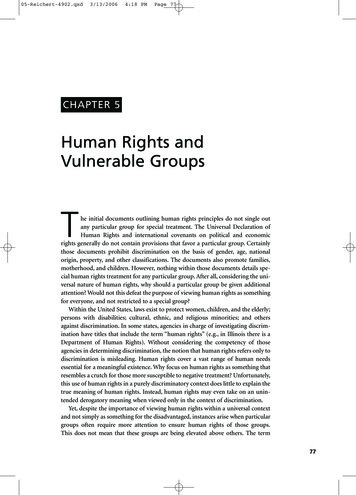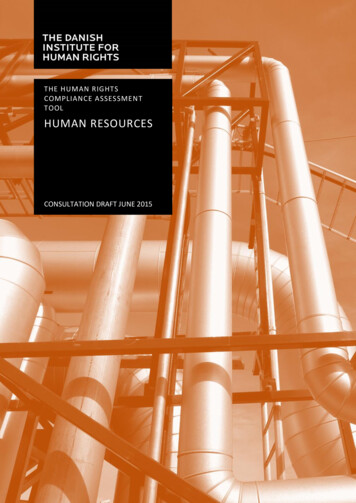
Transcription
THE HUMAN RIGHTSCOMPLIANCE ASSESSMENTTOOLHUMAN RESOURCESCONSULTATION DRAFT JUNE 20151
CONSULTATION DRAFT OF THE HUMAN RIGHTS COMPLIANCE ASSESSMENT TOOLHUMAN RESOURCES Danish Institute for Human Rights (DIHR), June 2015.The Danish Institute for Human Rights (DIHR) is an independent A-Status national human rights institutionmodelled in accordance with the UN Paris Principles. The Institute, which was established by statute in2002, carries on the mandate vested in the Danish Centre for Human Rights in 1987. This encompassesresearch, analysis, communication, information, education, documentation and the implementation ofnational and international programmes.The chief objective of DIHR is to promote and develop knowledge about human rights on a national,regional and international basis predicated on the belief that human rights are universal, mutuallyinterdependent and interrelated. The Institute believes that societies must be based on the rule of law,where the State protects and confers obligations on the individual while safeguarding the mostdisadvantaged and marginalised groups in society. The Institute cooperates with private entities,organisations and public authorities, with academic institutions and humanitarian organisations in Denmarkand in other countries, as well as with the Council of Europe, the EU, the OSCE, the UN, the World Bank anda range of international donors.This consultation draft was developed by the Human Rights Development Department of the DanishInstitute for Human Rights.For more information on this guide please contact DIHR at:Wilders Plads 8K, 1403 Copenhagen K, DenmarkTelephone: 45 32698888 Facsimile: 45 32698800E-mail: info@humanrights.dk Internet: www.humanrights.dkISBN-number: 978-87-91836-90-9TERMS OF USEThe HRCA is the sole property of the Danish Institute for Human Rights. We permit the free reproduction ofits contents provided that due acknowledgement is given.DISCLAIMERThis guide and the information contained therein are intended as a general guide to the issues addressed.They must not be considered a substitute for legal advice and questions regarding the legal interpretationand application of the information should be directed to appropriate legal counsel. Any actions taken oromissions or alterations made on the basis of this information are done at the user’s risk. The DanishInstitute for Human Rights is neither jointly nor individually responsible nor liable for any direct, indirect,consequential, special, exemplary, punitive or other damages arising out of or in any way related to theapplication or use of this guide and its information.2
CONTENTCONTENTSINTRODUCTION2.1 Employment Status and Dismissals2.2 Forced or Bonded Labour2.3 Child Labour and Young Workers2.4 Wages and Benefits2.5 Work Hours, Rest Periods and Leave2.6 Association and Collective Bargaining2.7 Equal and Fair Treatment2.8 Workplace Privacy2.9 Provision of Facilities to Workers4613274358911071431593
INTRODUCTIONWelcome to the Human Resources section of the Human Rights Compliance Assessment (HRCA)tool. This section concerns how human rights are respected when it comes to working conditions.1. MANAGEMENT3. WORKPLACE HEALTH2. HUMAN RESSOURCES4. PRODUCT QUALITY5. COMMUNITY IMPACTAND MARKETINGAND SAFETY6. SECURITY ARRANGEMENTS7. LEGAL AND8. CONTRACTORSGOVERNMENT AFFAIRSAND SUPPLY CHAINThe sub-categories for this section are: Employment Status and Dismissals Forced or Bonded Labour Child Labour and Young Workers Wages and Benefits Work Hours, Rest Periods and Leave Association and Collective Bargaining Equal and Fair Treatment Workplace Privacy Provision of Facilities to WorkersThis section has been through limited review in the latest update process. Most of the questionsand indicators have been through an external consultation process prior to the publication of thisconsultation draft.DIHR would like to engage with stakeholders on the content and implementation of the HRCA.This includes providing case studies, sending submission on specific components and engagingwith us on projects to improve and advance the content of the tool.4
To submit your feedback, go to the platform here: an-rights-indicators-for-business-hribYou can also contact us directly: hrib@humanrights.dk5
2.1 EMPLOYMENT STATUS AN D DISMISSALSNo. 2.1.1Area Human ResourcesSection Employment status anddismissalsQuestionYesDo all employees have an official employment status with the companyand know the terms of the employment contract or relationship?NoF/AN/ADescriptionAll workers, including young workers, are entitled to know their employment status with the company andthe working conditions. The risk of exploitative labour practices increases when a company exploits anindividual without recognizing or acknowledging his or her employment status within the company (eitheras an employee, a hired laborer or otherwise) and without providing him/her with the same employmentbenefits and protections as the other workers. To avoid this, the company should ensure that personnelpolicies and procedures empower all workers with some form of independent status, title or positionwithin the company.Suggested Indicators1Employee contracts detail each worker’sspecific rights and obligations ofemployment, and reference to any companyhandbooks or other documents that areintegrated into the contract.2Each worker either has an officialemployment status with the company or anemployment sis for assessment:6
Question references:Universal Declaration of Human Rights (1948), Article 4; International Covenant on Civil and PoliticalRights (1966), Article 8No. 2.1.2Area Human ResourcesSection Employment status anddismissalsYesQuestionNoF/AN/AAre layoffs administered fairly and in accordance with national laws andcollective bargaining agreements?DescriptionWhen faced with layoffs, the company must ensure that the process is conducted fairly and is not used totarget particular workers for dismissal (such as women, union members, minorities, disabled persons, or olderworkers). The closure of an entire department is less likely to lead to discriminatory dismissals than othertypes of layoffs, unless the department is dominated by a group of minorities. However, the company shouldstill ensure that the selection of departments for closure is based on fair business decisions. To mitigate theimpact of layoffs on company employees, anticipated layoffs due to corporate circumstances (e.g. downturnsin performance, takeovers, mergers) must be announced to the worker's representatives (or the workersthemselves if they are not represented) as soon as possible after the company becomes aware of thesituation, and give workers unions and employees an opportunity to negotiate and mitigate the layoffs beforethe final layoff decisions are made. When making the layoff announcement, the company must provide theappropriate national government authority and the worker's representatives (or the workers ifunrepresented/un-unionised) with all necessary information regarding the anticipated administration of thelayoffs. National governments may limit the scope of these responsibilities, depending on the number ofworkers affected by the layoffs.Suggested Indicators1The company complies with national law andcollective bargaining agreements whenadministering layoffs.TrueFalseF/AN/A7
2After announcing anticipated large-scalelayoffs, the company requests proposals fromworker's representatives to minimise theimpact of the layoff, and negotiates over theproposals in good faith.3The company considers alternatives to layoffsincluding placement options for employees toremain employed with the company,reduction in hours and/or limitation onovertime hours, voluntary early retirementoptions, and training opportunities to assistemployees to transition to another workenvironment.4The company respects the seniority of itsemployees and complies with all seniorityprovisions of the collective bargainingagreement.5The company hires an independent party (ortakes other such measures) to assessretrenchment or layoff processes to ensurethat it is carried out in a fair lseF/AN/ATrueTrue8
6The company draws evenly from allbargaining units and does not use the layoffas a justification for dismissing members ofparticular unions.7When layoffs are anticipated, the companyinforms the national government authorityand worker's representatives about cause ofthe layoffs, the time frame, the number ofworkers likely to be affected, and any otherrelevant information.8The company does not use the layoffs todiscriminatorily or arbitrarily dismiss anyworkers or groups of N/AComments:Basis for assessment:Question references:Universal Declaration of Human Rights (1948), Articles 2 and 23; International Covenant on Civil andPolitical Rights (1966), Article 26; Convention on the Rights of Persons with Disabilities Article 27; ILODiscrimination (Employment and Occupation) Convention (C111, 1958), Article 1; ILO Indigenous andTribal Peoples Convention (C169, 1989), Article 20; ILO Termination of Employment Convention (C158,1982), Part II, Articles 4, 5 and 6, 13 and 14; ILO Tripartite Declaration of Principles ConcerningMultinational Enterprises and Social Policy (1977), Articles 26 and 27; ILO Termination of EmploymentConvention (C158, 1982), Article 13(1)(a) and Article 14(1))9
No. 2.1.3Area Human ResourcesSection Employment status anddismissalsQuestionAre dismissals conducted in a fair manner, which provides adequateprocedural safeguards and compensation where appropriate?YesNoF/AN/ADescriptionExcept in cases of serious misconduct, an employee must be given reasonable notice before beingterminated. "Serious conduct" is misconduct that is so unreasonable that it would be unreasonable toallow the employee to maintain his employment during the notice period. 'Reasonable notice' is notdefined by international standards, but national law in the country of operation often prescribes noticeprovisions. When setting its own notice policies, or relying on national law notice provisions, thecompany must consider the amount of time it would reasonably take to make the necessaryarrangements to adjust to the loss of employment, such as finding a new job, or getting unemploymentbenefits. If operating in a country where unemployment is high and unemployment insurance is low ornon- existent, for example, the company must give a longer notice period than it would otherwise give.Workers must also enjoy certain protections, such as the opportunity to defend themselves againstallegations or respond to the reasons for dismissal. An exception to this is when the company cannotreasonably be expected to provide such an opportunity (e.g. the worker's presence on companyproperty presents a serious threat of danger to other employees). Although the actual proceduralsafeguards owed to an employee in a performance related dismissal are not detailed by internationalstandards, national law may provide relevant guidance. At a minimum, the opportunity to defendoneself should include prior notice of the allegations, an opportunity to question otheremployees/management, adequate union representation, if applicable, and a fair hearing.Suggested Indicators1The company has guidelines stating areasonable period of notice before dismissal,or relies on national law, if national lawprovides a reasonable notice period.2If reasonable notice cannot be provided to adismissed employee, monetary compensationis provided in lieu of advance notice, at a rateof at least equivalent to compensation for theperiod of reasonable notice.TrueTrueFalseF/AN/AFalseF/AN/A10
3If the company is considering dismissing anemployee because of dissatisfaction with theemployee's performance, the employee isgiven written notice of the problem, theopportunity and time to respond to the claim,and the opportunity and time to improveperformance and avoid dismissal.4The employee is provided with theopportunity to defend himself, consult with aworker or union representative, to haverepresentation at a disciplinary proceeding,have the union representative present at thehearing, and to call witnesses on his or herbehalf.5The disciplinary processes reflect that theemployer has the burden of showing a validreason for dismissal.6The company provides the employee with theright to appeal to an independent tribunal,committee, court or /ATrueFalseF/AN/ATrue11
Comments:Basis for assessment:Question references:Universal Declaration of Human Rights (1948), Article 23 and 25; International Covenant on Economic,Social and Cultural Rights (1966), Article 7; ILO Termination of Employment Convention (C158, 1982),Article 7, 8 and 1112
2.2 FORCED OR BONDED LABOURNo. 2.2.1Area Human ResourcesSection Forced or bonded labourYesQuestionNoF/AN/ADoes the company refrain from threatening or coercing employees to workagainst their will, up to and including the use of violence?DescriptionEven if an employee is compensated for his or her work, forced labour can still take place due to improperinfluence or threat of punishment. Excessive working hours or prolonged periods without rest may indicatethe use of threats or other forms of coercion. Similarly, if the company threatens an employee with disciplineor termination if he or she does not work excessive overtime hours or remain on the premises between shiftswithout a rest break, this also amounts to a violation of the right to freedom from forced labour. Verbal orphysical abuse may not be used to exact labour from workers. Impermissible disciplinary measures includeintimidation, harassment, discrimination and violence, whether physical or psychological.Suggested Indicators1Company policy prohibits forced labour,servitude and the use of involuntary prisonlabour.2Managers and other staff do not threaten orforce employees to work overtime, skipbreaks or rest allowances, or otherwise workagainst their will.TrueTrueFalseF/AN/AFalseF/AN/A13
3Company guidelines prohibit the use ofphysical and psychological threats,punishment or other disciplinary measures forforcing employees to work overtime orwithout pay.4Company supervisors and security staff aretrained to use appropriate disciplinarytechniques and measures.5The company requires that managersdocument all disciplinary measures takenagainst a worker and that the worker receivesa copy of such documentation, which he orshe is able to respond to.6The company requires the immediatesuspension of any personnel found to beinflicting or threatening corporal /ATrueFalseF/AN/ATrue14
7If the company employs young workers, hiringmanagers obtain their consent directly fromthe worker outside of the presence of parentsor guardians.TrueFalseF/AN/AComments:Basis for assessment:Question references:Universal Declaration of Human Rights (1948), Article 4 and 5; International Covenant on Civil andPolitical Rights (1966), Article 8; International Covenant on Economic, Social and Cultural Rights (1996),Article 7 (b); Convention on the Protection of the Rights of All Migrant Worker and Members of TheirFamilies (1990), Article 11 (2); ILO Forced Labour and Servitude Convention (C29, 1930), Articles 12 and13; ILO Declaration on Fundamental Principles and Rights at Work (1998), Article 2(b); ILO ConventionConcerning Minimum Wage Fixing with Special Reference to Developing Countries (C131, 1970)No. 2.2.2Area Human ResourcesSection Forced or bonded labourQuestionYesNoF/AN/ADoes the company refrain from retaining the identity cards, passports, andother important personal documents of its employees?DescriptionWithholding of employees' travel documents and identity cards results in an unreasonable restriction on theirfreedom of movement and travel. It may also limit the individual's ability to apply for jobs with othercompanies, or to leave the country.15
Suggested Indicators1If employees need letters of release to seekother employment, they are issuedautomatically and upon request immediately.2The company only keeps employees'documents for short periods while makingphotocopies or copying information foremployees' personnel files.3The personnel files (and other relevant files)contain no original personal documents orpersonal AN/AComments:Basis for assessment:Question references:Universal Declaration of Human Rights (1948), Article 4; International Covenant on Civil and PoliticalRights (1966), Article 8 and 12 (1); Convention on the Protection of the Rights of All Migrant Worker andMembers of Their Families (1990), Article 21; ILO Forced Labour and Servitude Convention (C29, 1930);ILO Abolition of Forced Labour Convention (C105, 1957), Article 116
No. 2.2.3Area Human ResourcesSection Forced or bonded labourQuestionYesDoes the company avoid hiring workers into bonded labour relationshipsinvolving salary advances or loans?NoF/AN/ADescriptionAdvancing salary in the form of a loan does not necessarily result in a bonded labour employmentrelationship. However, such an arrangement could amount to bonded labour under certain circumstances,such as when the debt repayment cycle is never-ending, the debt is excessive, and the repayment terms areso unfair that the employee must continue to work for the company in order to pay off the loan. TheInternational Labour Organisation directs states to develop policies limiting the amount of advancements paidto a worker, and many states prohibit the advancement of more than one or two month's salary. In generalterms, the company should be wary of any advances that create a debtor relationship where the employee orhis or her family is constrained from leaving the company, unable to pay his or her own living expenses orincapable of repaying the debt in a reasonable amount of time. Each case is fact specific, however, and shouldbe analysed in the context of the indicators listed below.Suggested Indicators1Written procedures detail the proper use ofloans or salary advances.2Any available loan or salary advancerepayment terms are explained to the worker,in a language understood by the worker, andare included in a written agreement signed bythe worker.TrueTrueFalseF/AN/AFalseF/AN/A17
3Loan or salary advance terms must bereasonable, at prevailing market interest ratesor less, and the terms to not restrictemployee's ability to change job or employer,or return to their place of origin if they aremigrant rueFalseF/AN/AVerification: Records - loans/advances4Loans or salary advance terms do not involvemembers of the employees family, forexample by requiring them to work to pay offthe debt.TrueVerification: Employee representatives5Loans and salary advances are not made on acyclical basis, placing employees in acontinued process of debt and repaymentwith the company.Verification: Records - loans/advances6If employees take out repeated loans or salaryadvances for living expenses, the company reevaluates its living wage policies and/orinstitutes a program to rehabilitate long-termindebted employees.Verification: Management18
Comments:Basis for assessment:Question references:Universal Declaration of Human Rights (1948), Article 4; ILO Social Policy (Basic Aims and Standards)Convention (C117, Article 12); Supplementary Slavery Convention (1956), Article 1(a); ILO Protection ofWages Convention (C95, 1949)No. 2.2.4Area Human ResourcesSection Forced or bonded labourQuestionDoes the company refrain from withholding wages in an attempt to coerceadditional labour from employees, or demanding deposits for any reason?YesNoF/AN/ADescriptionThe company must reimburse employees and hired labourers fairly and in a timely manner. The companymust not demand deposits (e.g., money or wage deductions) from employees for any purpose, as this maybind the employee to the workplace and restrict their freedom of movement. Under no circumstance may itwithhold wages in order to discipline workers or to extract additional labour from them. If the company relieson an authorized form of forced labour, it should either reimburse the forced labourer directly or ensure thatthe responsible governmental authority facilitates the reimbursement. The company should also refrain fromusing employment agencies that demand deposits from employees.Suggested Indicators1Company procedures provide that workers bepaid in accordance to the work provided andin a timely manner.TrueFalseF/AN/AVerification: Policy19
2Workers are paid on a regular basis and inaccordance with the amount of AN/AVerification: Employee representatives,Records - payroll3Company procedures provide that onlyauthorized, voluntary and legitimatedeductions are made from workers' salaries.Verification: Guidelines4The company has fixed procedures for hiringemployees, ensuring that the company doesnot demand deposits or use employmentagencies that demand deposits fromemployees.TrueVerification: Guidelines - wagesComments:Basis for assessment:Question references: Universal Declaration of Human Rights (1948), Article 4 and 23;International Covenant on Economic, Social and Cultural Rights (1966), Article 7; InternationalCovenant on Civil and Political Rights (1966), Article 8; ILO Forced Labour and ServitudeConvention (C29, 1930), Article 14; ILO Protection of Wages Convention (C95, 1949), Article 1220
No. 2.2.5Area Human ResourcesSection Forced or Bonded LabourQuestionAre company employees free to move around and leave theworkplace and housing facilities, limited only by yees must not be held at company premises or housing against their will, even if the intent of therestriction is to bring the company in conformance with local laws or cultural practices (e.g. prohibitingwomen from freely moving about without a male escort). Reasonable restrictions on movement arepermissible when necessary to maintain order or safety in the workplace, such as when a company requiresits employees to sign in or clock out when entering or departing company facilities, or for legitimatebusiness interests, such as protecting competitive interests and limiting access to sensitive areas. If thereare security concerns in the location of operation, the company may request employees to depart thepremises at certain intervals in order to be escorted through hazardous areas by security personnel.Suggested Indicators1The physical environment provides foraccessibility by employees with disabilities,such as accommodation for persons inwheelchairs, to provide them with access toall facilities on an equal basis.2Any existing restrictions on employeemovement within the company arereasonable and serve an important interest.TrueTrueFalseF/AN/AFalseF/AN/A21
3Security control and monitoring of employeewhereabouts are done by non-intimidatingmeans, such as by signing employees in andout of work areas, or monitoring requiredcheckpoints.4Company employees do not enforce any locallaws or practices that restrict women frommoving about or departing until an escortarrives.5Company security personnel do not threatenor stop employees from leaving companypremises.6Doors, entrances to hallways, and exits fromthe premises are not blocked, and employeesmay freely use them to come and go withoutobstruction.7A grievance mechanism allows for the safereporting of all workplace grievances,including complaints about workplacemovement AN/ATrueFalseF/AN/ATrueFalseF/AN/ATrue22
8A grievance mechanism allows for the safereporting of all workplace grievances,including complaints about workplacemovement restrictions.TrueFalseF/AN/AComments:Basis for assessment:Question references: Universal Declaration of Human Rights (1948), Article 4; International Covenanton Civil and Political Rights (1966), Article 8 and 12 (1), International Covenant on Economic, Social andCultural Rights (1966), Article 7 (b); Convention on the Rights of Persons with Disabilities (2008) Article 9No. 2.2.6Area Human ResourcesSection Forced or Bonded LabourQuestionYesNoF/AN/AIf the company sources labour from a correctional facility or othergovernment authority, does the company ensure that labourers havevoluntarily consented to work and that the labourers are appropriatelyremunerated and supervised?DescriptionDepending on the circumstances, the company may hire the services of forced labourers serving out courtsentences or civil obligations required by law. Such 'captive' individuals or groups may range from convictedprisoners to conscientious objectors. Despite the prohibition against most types of forced labour,governments may still lawfully exact forced labour from such captive individuals. In other words, prisoners,conscientious objectors and other captives need not consent to mandated labour if it arises as a form oflawful punishment or as the fulfilment of essential civil obligations. Nevertheless, international law doesrequire obtaining the consent of captive individuals to any labour that directly benefits private companiesor individuals. A private company may only utilise the service of a prisoner if the prisoner truly consents tothe proposed work. But consent can be particularly difficult to obtain from captives because their decisionscan be easily swayed by their captors' direct and indirect actions. For instance, a prisoner might have nochoice but to work, rather than face substandard conditions or treatment at the hands the prison authority.A prisoner in such a situation would not have the ability to accept or decline work freely and could,therefore, not freely consent to the labour. However, if the prisoner earnestly desires to gain vocational23
skills or compensation for his efforts, he might be in a realistic position of giving his true consent to theproposed labour. Due to the particular vulnerability of captive groups, the company must be very cautiousif hiring captives, and must ensure that they have given their true consent to work for the company. If thecompany knows or has reason to believe that a particular labourer did not have the ability to give trueconsent, the company should refrain from utilising the services of that individual.Suggested Indicators1The company gets the express written andverbal consent of all hired labourers, includingprison labourers and conscientious objectors,before they start their work.2If the company knows or suspects thatgovernment or correctional authorities useunlawful ways of pressuring captiveindividuals to work, the company stopssourcing labourers from the government orcorrectional authorities.3When using voluntary prison labourers orother compulsory labourers, the companyonly uses able-bodied men or womenbetween the ages of 18 and 45.TrueFalseF/AN/ATrueFalseF/AN/ATrueFalseF/AN/A24
4Prison labourers are paid directly in cash or inkind5Prison labourers and conscientious objectorsare informed about and provided access tothe company grievance procedure, for anygrievances including those regardingcondition of forced labour.6Any forced labourers that are provided byprison authorities or in compliance withinternational law are supervised by theappropriate governmental authority.7Compensation to workers sourced throughgovernment or correctional facilities meetsthe minimum standards in the area.8The company has not been the object ofallegations of non-consensual workingconditions or severe disciplinary AN/ATrueFalseF/AN/ATrueFalseF/AN/A25
Comments:Basis for assessment:Question references: Universal Declaration of Human Rights (1948), Article 4; International Covenanton Civil and Political Rights (1966), Article 8; ILO Forced Labour Convention and Servitude (C29, 1930);UN Standard Minimum Rules for Treatment of Prisoners (1977), Articles 71-7626
2.3 CHILD LABOUR AND YOUNG WORKERSNo. 2.3.1Area Human ResourcesSection Child labour and youngworkersYesQuestionNoF/AN/ADoes the company respect minimum age standards in its hiring practices?DescriptionAll businesses should refer to ILO Convention No. 138 on the minimum age for admission to employmentand work, and comply with national law or international standards, whichever is higher. Where permittedby national law, a company, its supplier or subcontractor, may employ children to perform a few hours oflight work per day. ‘Light work’ involves simple, limited tasks performed under adequate adult supervision– and it must not interfere with children’s educational opportunities.No child under 18 years old should ever be engaged in the worst forms of child labour, defined in ILOConvention 182 as: (a) all forms of slavery, the sale and trafficking of children, debt bondage and serfdom,and forced or compulsory labour, including recruitment of children for use in armed conflict; (b) the use,procuring or offering of a child for prostitution, or production of pornography; (c) the use, procuring oroffering of a child for illicit activities, in particular for production and trafficking of drugs; and (d) work thatis likely to harm children’s health, safety or morals. The last item is also referred to as ‘hazardous’ work,which typically includes long working hours, work at night, work at dangerous heights, or work withdangerous machinery, equipment and tools; the transport of heavy loads; exposure to hazardoussubstances or processes; unreasonable confinement to the employer’s premises.Suggested Indicators1The company has a policy, clearly stating theminimum age for employment in line withnational law or international standards,whichever is higher.2T
Welcome to the Human Resources section of the Human Rights Compliance Assessment (HRCA) tool. This section concerns how human rights are respected when it comes to working conditions. The sub-categories for this section are: Employment Status and Dismissals Forced or Bonded Labour Child Labour and Young Workers Wages and Benefits





